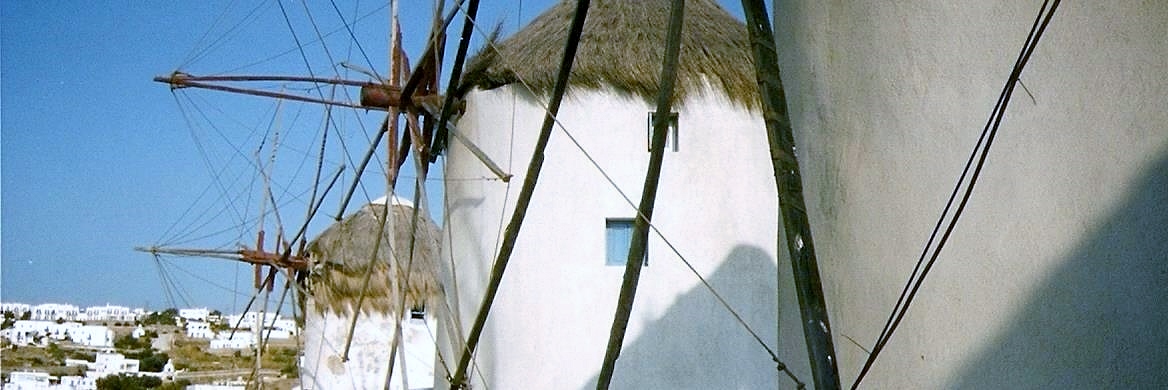
greece
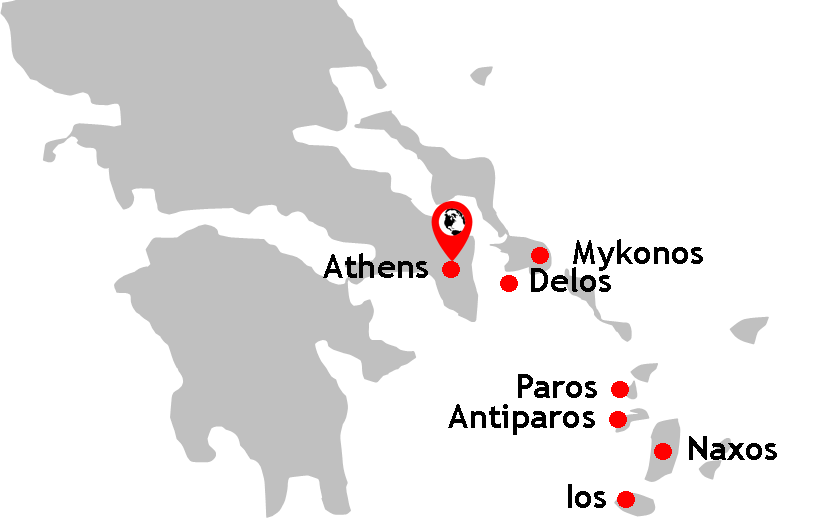
Where: Athens, Naxos, Delos, Ios, Mykonos, Paros, Antiparos. Greece, Europe.
When: August 2004
What: Delos Lions, Acropolis, Parthenon, Athens Amphitheatre, Greek Ferry System, Greek Parliament, Temple of Hephaestus, Windmills, the Mykonos pelican, Statue of Emperor Hadrian, Paros Caves, Iconic Blue Dome Orthodox Churches.
How: Flight, Walk, Taxi, Greek Ferry System, Pick-up truck.
Country counter: No.5
Mishaps or illnesses: Developing a heat rash which was so bad it required a visit to a private medical clinic where I was injected with some unknown liquid - after which I very nearly passed out; sneaking into a private upstairs area of Athens Airport to sleep until our flight the following morning - and being ejected by unimpressed security guards.
Greece was a real adventure. There was no plan and no advanced booking for hotels on these islands. This meant that as soon as we got itchy travel feet we could hop to another island. By the same token, if we found an island we really liked, or were becoming a little tired, we could rest up for a few more days. This was my first holiday where there was a real sense of adventure: moving on from location to location and leaving the decision about when to move on, and to where, to the last minute. Nothing was booked in advance, including the accommodation. We merely filled in the itinerary as we went along, with only our incoming and outgoing flights acting as the nomadic bookends of the journey. Everything else in-between was negotiable, flexible and "to be determined". Following the well-trodden backpacker tradition of leaving accommodation until the last minute, we'd arrive in port and step off the ferry to be surrounded by a gaggle of local islanders waving laminated signs hoping to rent us a spare room for the night. These were often intense but exciting exchanges, a veritable scrum of locals and tourists engaged in the art form of bartering. If you are planning on approaching your trip like this, my advice is to take a pen and paper - handy tools to clarify prices and make sure an agreed price does not get translated into a higher one when you come to pay. Not having a bed for the night, and leaving it until we stepped off the ferry, was one of the most exciting aspects of our trip around the Cyclades. We had a ceiling amount per night over which we would not go. Room owners, a real mixed bunch who were trying to let anything from entire luxury apartments to a renovated garage at the bottom of their garden, were keen to secure us for second and third nights, meaning we could often strike great deals over price - presumably because it meant they didn't have to make their way back down to the harbour the next day to get their next island hopper and thus giving them a valuable afternoon off in the Greek sun.
The Greek ferries were fun to use and went a long way to making me feel more intrepid explorer than tacky tourist. The experience on board, after the general scrum of boarding and disembarking, was often a restful affair. Indeed, it was frequently possible to find a quiet spot on the ferry where no other passengers were in order to watch the departure island fade into the distance and the next island ahead of us hone into view. There was also time, on occasion, to play cards.
My only regret about this trip is that I didn't manage to take better and more numerous photographs of the adventures we had. As it stands, the ones below represent the very best of what I have (and even these have had software applied to help bring them up to a publishable standard). My fortnight-long hopping adventure around the Greek Islands of the Central and North Cyclades was in the pre-digital age and thus these are the best my old-style 35mm camera could muster back then. At least I have the memories.
athens
Our first stop was the capital city of Athens - the entry destination of our flight from the United Kingdom. I am always keen that a trip to a country should, in most cases, capture the capital city somewhere in the itinerary and, as a consequence, we spent three days exploring the ruins of ancient Greece including the Acropolis Parthenon and the stunning Athens Amphitheatre. The vistas and almost 360° views of Athens from the top of the Acropolis Hill were worth the steep climb in the rapidly increasing steamy heat of a Greek summer day. Of course, a visit to Athens is just a visit to a capital city. A visit to Athens is simultaneously a visit to the birthplace of Western Civilisation.
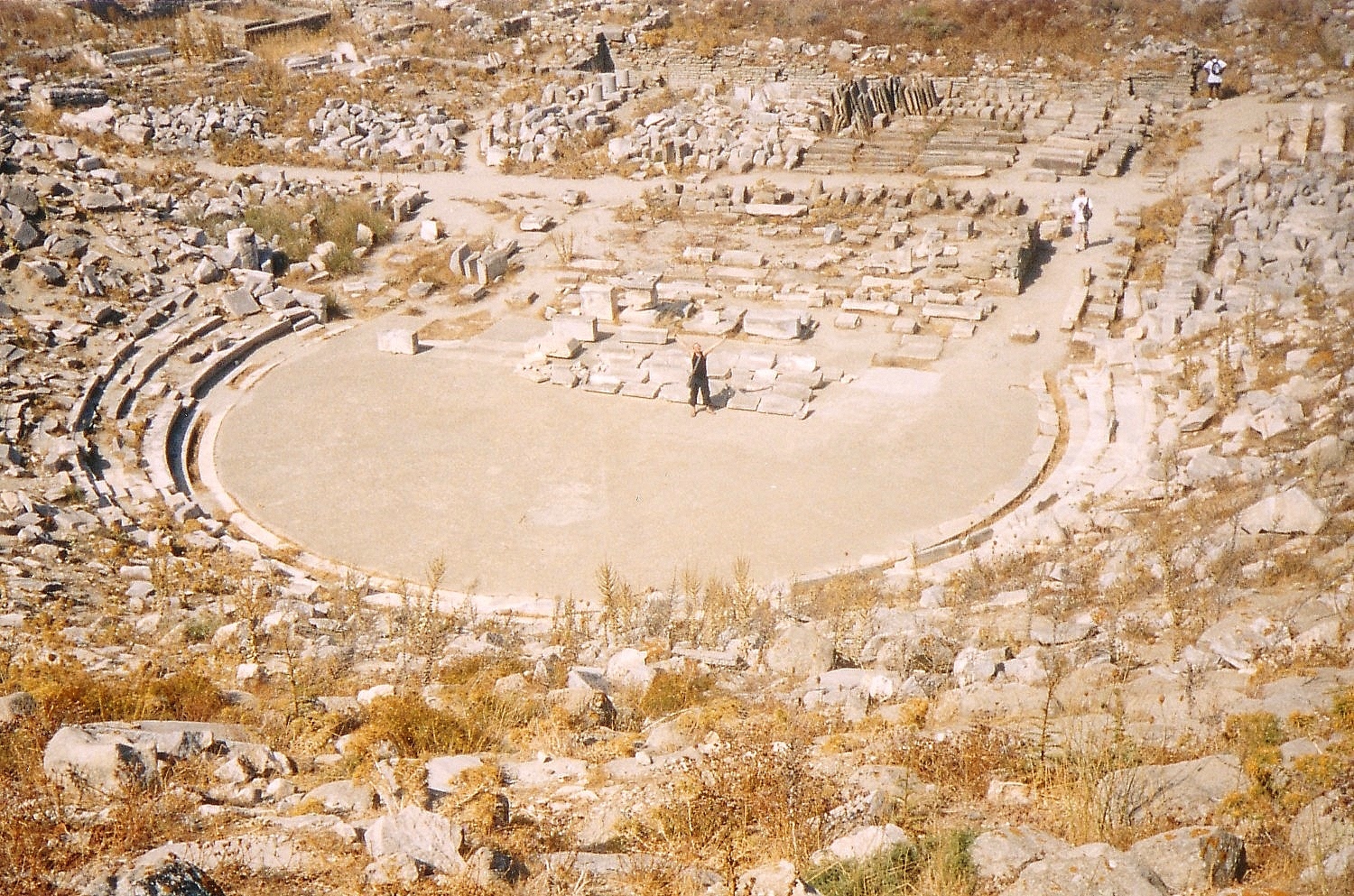
Athens' amphitheatre as seen from above (I'm the black speck in the middle).
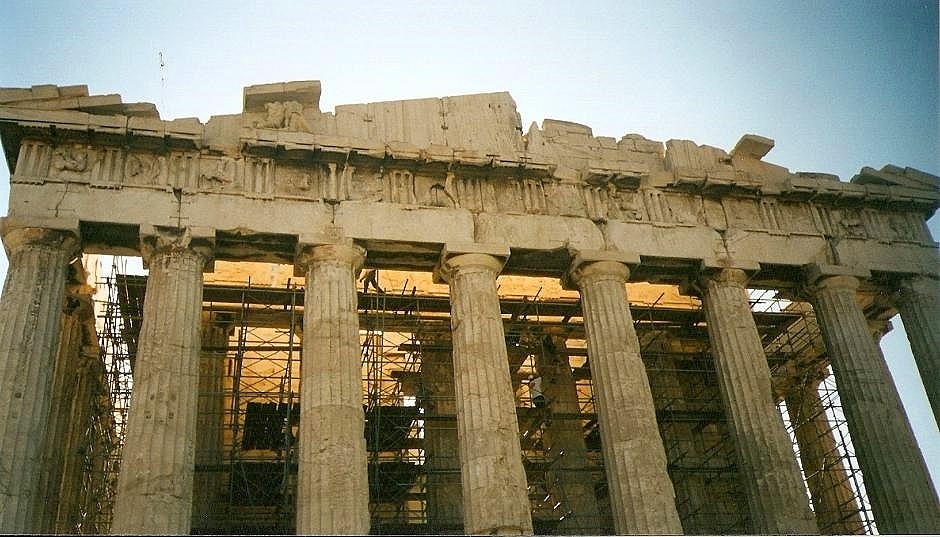
Parthenon on Acropolis Hill: built six millennia before Christ. Christ!
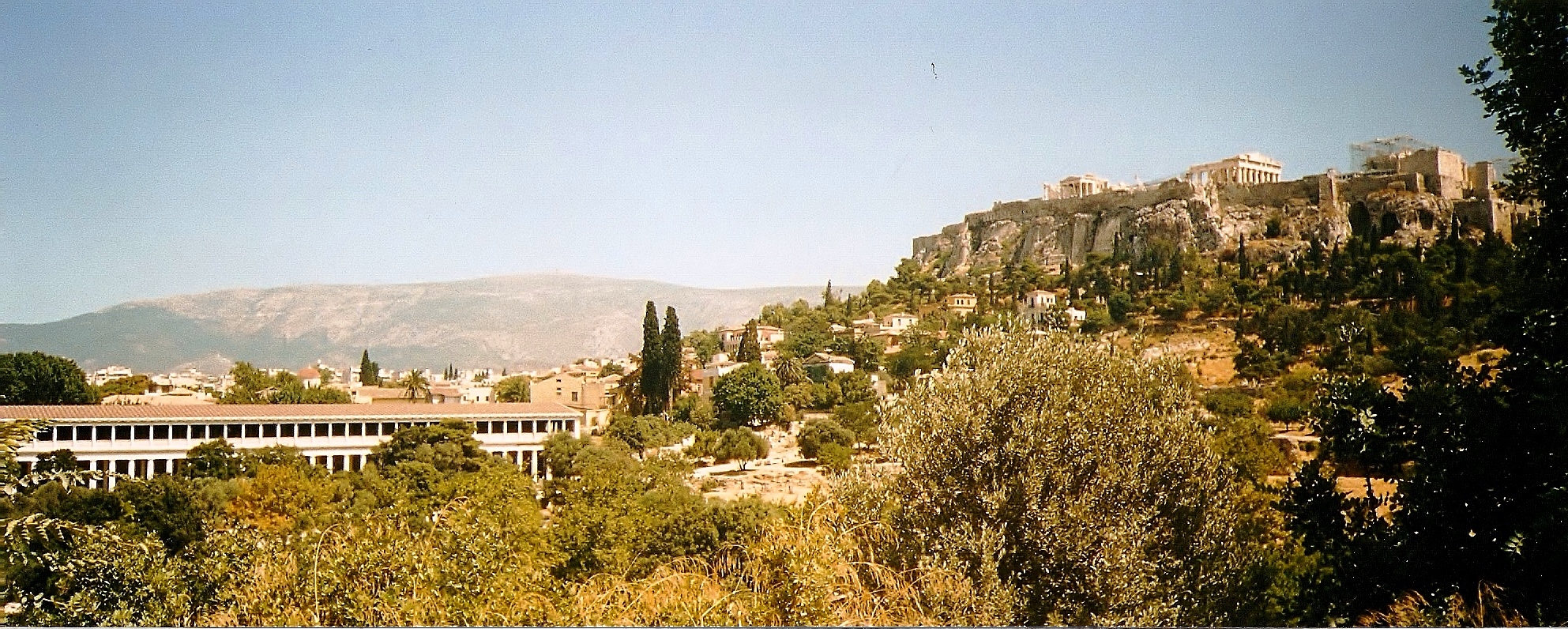
The view of Acropolis Hill and the Parthenon in the sun.
paros & antiparos
Arriving at each port was a veritable scrum, with desperate islanders hoping to let their rooms, sheds, basements and bedrooms to backpackers like us in search of a bed. We arrived at the island and hooked up with one of the many locals vying for our stay. Indeed, at Paros, I was quickly bundled onto the back of a truck and whisked to our first place where we would spend the night. This, my first experience of arranging accommodation on the spot hovered uneasily between exciting, impromptu transfer service and crazed kidnapping. Once I was sure it was, indeed, the former I began to relax and enjoy the warm Greek air as I bounced around in the tray of the truck. Shortly after disembarking we were both reunited and lead to a small outhouse at the bottom of the man's garden. It was pleasant enough, that's for sure. It had whitewashed walls, crisp and clean linen, and, more importantly, an electric fan - without doubt an obligatory item in the evening heat of a Greek summer. I remember feeling rather proud of bagging our first stay for a knockdown price. Indeed, it is fair to say that travel like this is a real adrenaline boost. We then stayed for one night on Antiparos, which was not unlike its sister island; laid back and understated. I'm glad we chose a couple of the Cyclades' quieter islands. This not only gave us a little time to orient ourselves but also meant we got to experience a slice of island life away from the more frequented islands.
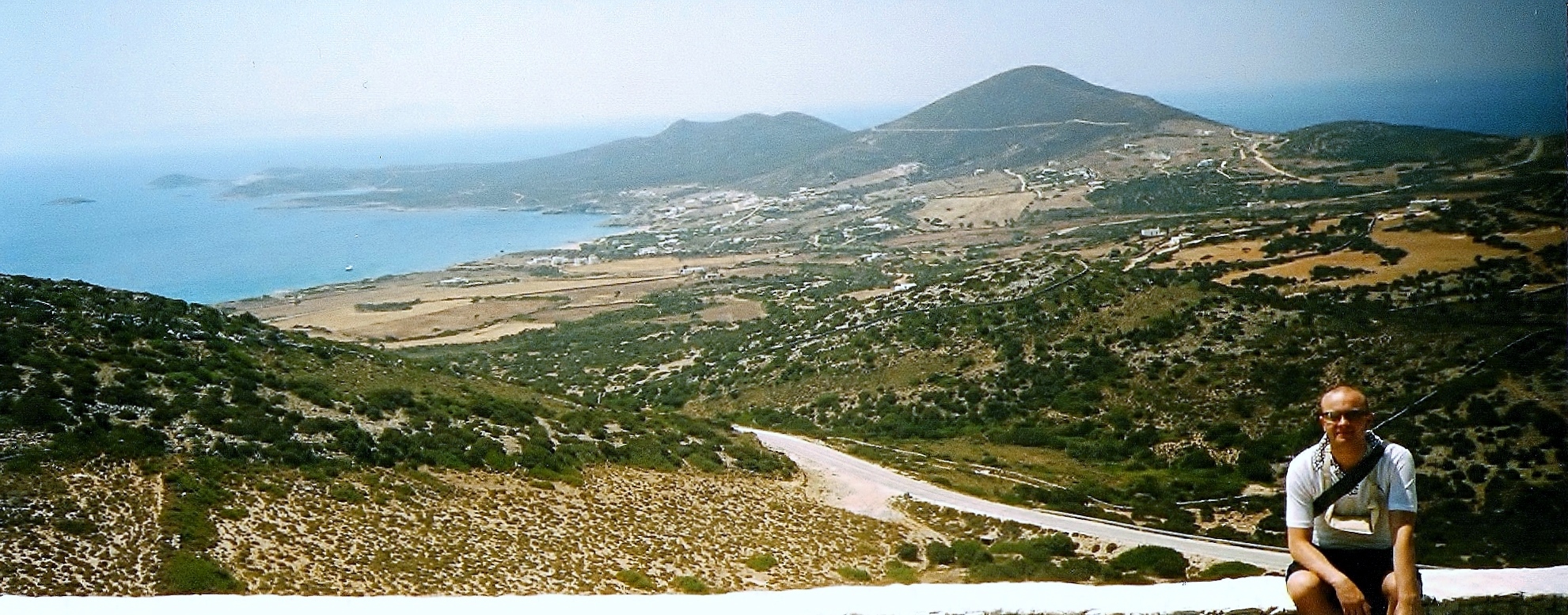
Overlooking the hills outside the Paros Caves in Paros.
mykonos
I suppose no island hopping adventure around the Greek Islands would be complete without a stop on Mykonos, famed for being Greece's hedonistic party island with a reputation to rival that of Ibiza's. Its fame precedes it and, for this reason, you'll soon find, as we did, that you leave the tranquillity and relaxation of other islands firmly behind you. Mykonos may be busy, very touristy and unpalatably expensive, but this does not mean it is not pretty. Indeed, the view of Little Venice is iconic in its own right, with its pastel-washed cubed dwellings clinging to the coastline Venice-like, their uniformity interrupted only by the iconic blue domes of Greek Orthodox churches. Also of note are the legendary pink pelicans on the island. In the 1950s a wounded pelican was found by a fisherman off of the Mykonos coast. It was taken in-land and nursed back to health, choosing to stay on the island until 1985. It was given the name Petros - a word which translates as Grumpy. Since then, three other pelicans have made the island their home and, as I was to find, one was not averse to being stroked.
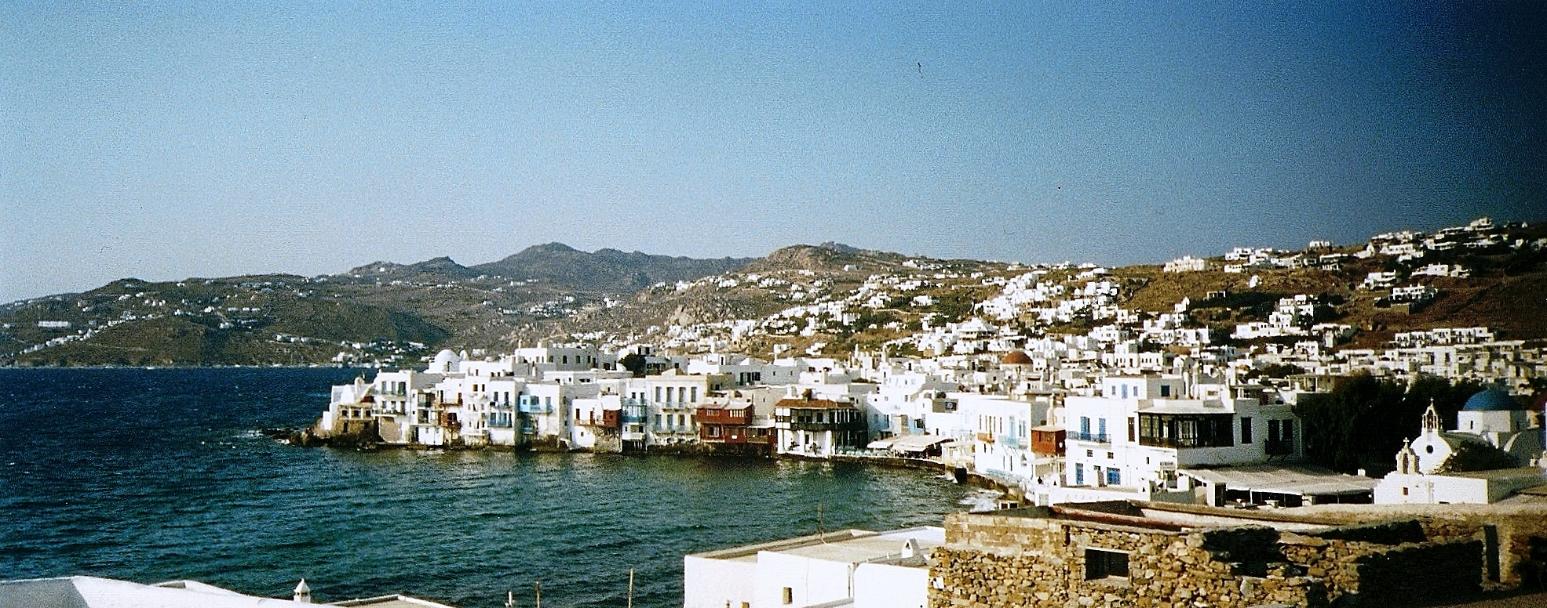
The view known as 'Little Venice'. It is rather stunning - but old-style photography fails to do it justice.
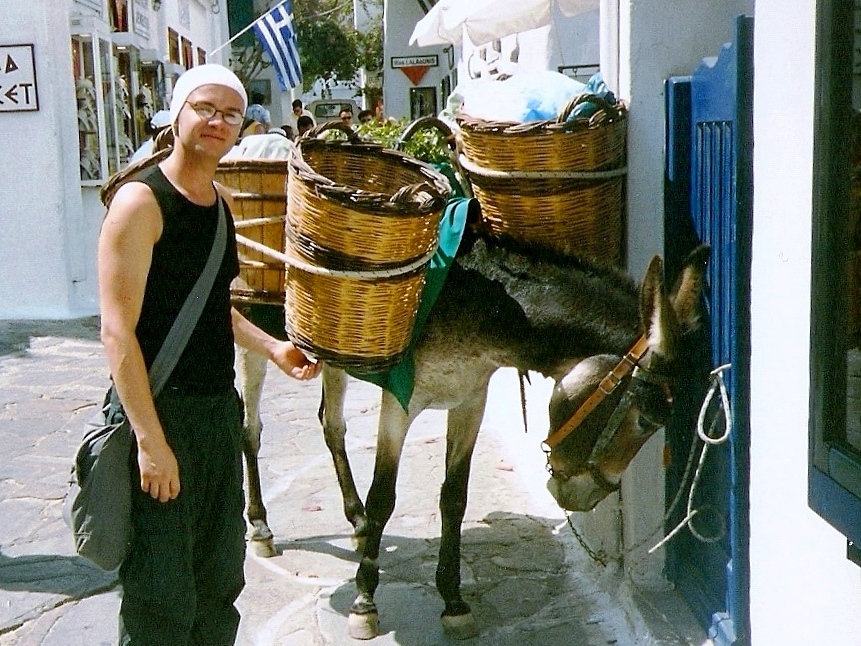
Island creatures: stroking a donkey on Gold Market Street.
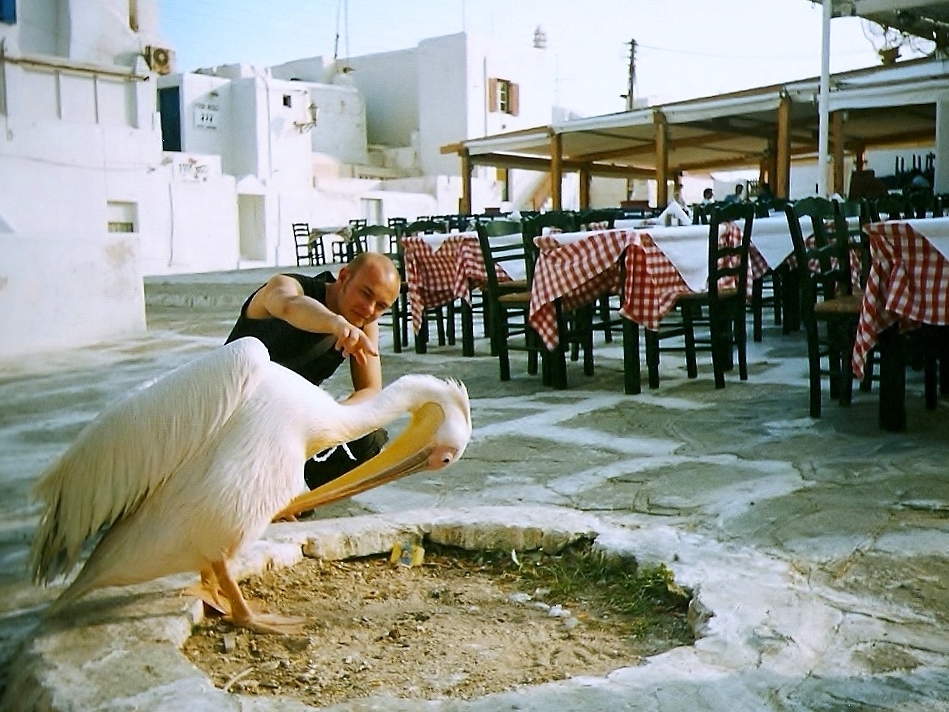
Stroking the famous Mykonos pelican.
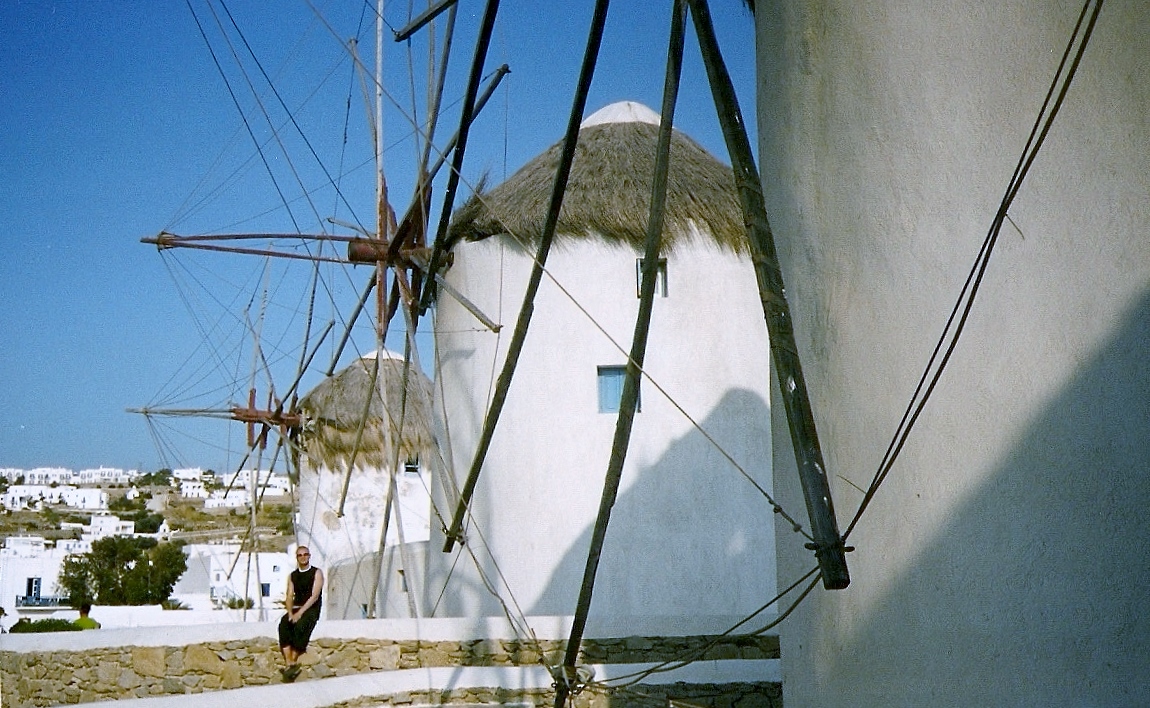
Mykonos' white windmills are as iconic as they are evocative.
delos
A satisfyingly-short ferry journey from Mykonos to Delos brings you to the Lilliputian island of Delos. This is an island with no inhabitants - apart from, that is, the evocative and wonderful stone Delos lions which date back to an incredible 550BC. They were a gift from the people of Naxos island to Delos to stand as stone guards at the Sanctuary of Apollo. Their neat alignment in rows and general appearance are not dissimilar to the Avenue of the Sphinxes at Luxor Temple in Egypt which I was to visit many years later. Unfortunately the time you can spend with Delos' wonderful stone creations is dictated by return ferry times - miss the last ferry and spend the night on an uninhabited island. Delos, therefore, is a day trip option only.
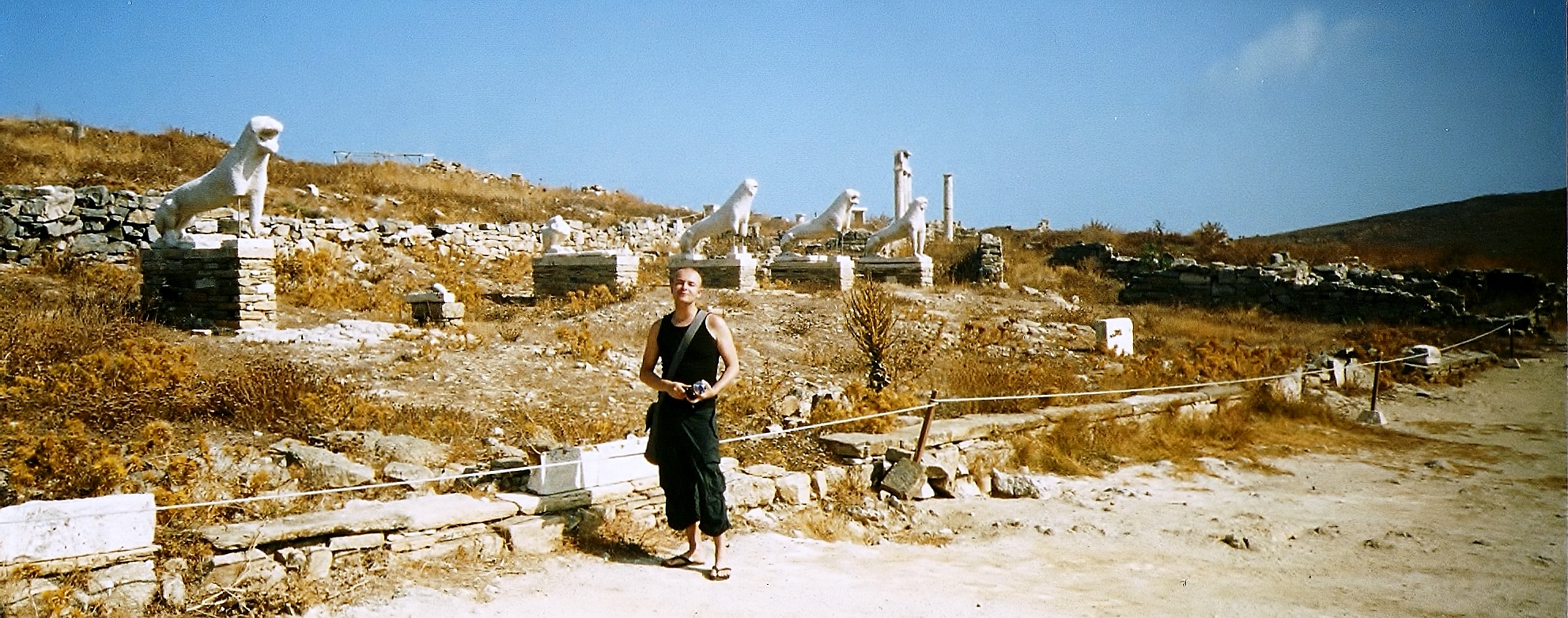
The delightful Delos Lions on Delos Terrace - a gift from Naxos people to Delos to guard the Sanctuary of Apollo.

Amid ruins on the Delos Terrace.
naxos
Every Greek island, as any Greek themselves or, indeed, seasoned visitor to these islands will attest, has its own personality. This was no more true than in the case of the mighty Naxos - its looming arch the first thing greeting you as you make your watery approach to the island and which certainly quickened my heart beat with excitement and anticipation as the island honed into view. Naxos welcomes the tourists but retains its authenticity. This is a local island for local people which, thankfully, hasn't succumbed to the warping influences of the visitor. Fishing lies at Naxos' heart; it's a memorable experience just to wander up and down the main street to see the variety of species of octopuses and squids dangling from all manner of street stalls, alfresco terraces and restaurants. Here, on display is the Greekest of Greek palates. Lacking any sense of adventure (I am not a fan of such sea creatures as my source of sustenance) I was lucky enough to find an eatery which catered to a more Western (for "Western" read "boring") fayre, namely pizza. Unashamedly I clung to that restaurant for dear life during my stay on Naxos for, I believe, crazy-looking sea creatures should be left in the sea. Naxos was an island slightly off the beaten track and, according to Greeks themselves, a more archetypal Greek island in Greece you will not find. For this reason alone Naxos is worth inclusion on the itinerary of any traveller wishing to experience authentic island life in Greece.
Unfortunately for me, a little too much sunbathing on Naxos resulted in my developing a large red rash all over my hands and face, with additional sunlight only aggravating the matter further. With direct sunshine rather difficult to avoid when you are travelling around Greece in the height of the summer months, we sought out medical assistance. We came across a small clinic with the obligatory red cross emblazoned across the door and went in. Explaining the situation was quite simple requiring, as it did, merely pointing to the offending red spots on my face and hands. The doctor took to injecting me with, well, something. To this day I have no idea what it was. The injection had the unwanted side effect of making me nearly faint. Indeed, this was the closest I have ever come to fainting over anything. The bill was €40 - a not insubstantial sum to a backpacker like me. Naively I proffered my E111 card to the doctor as payment who shrugged it away and kindly remarked that only cold hard Euros were acceptable. Travel, eh?
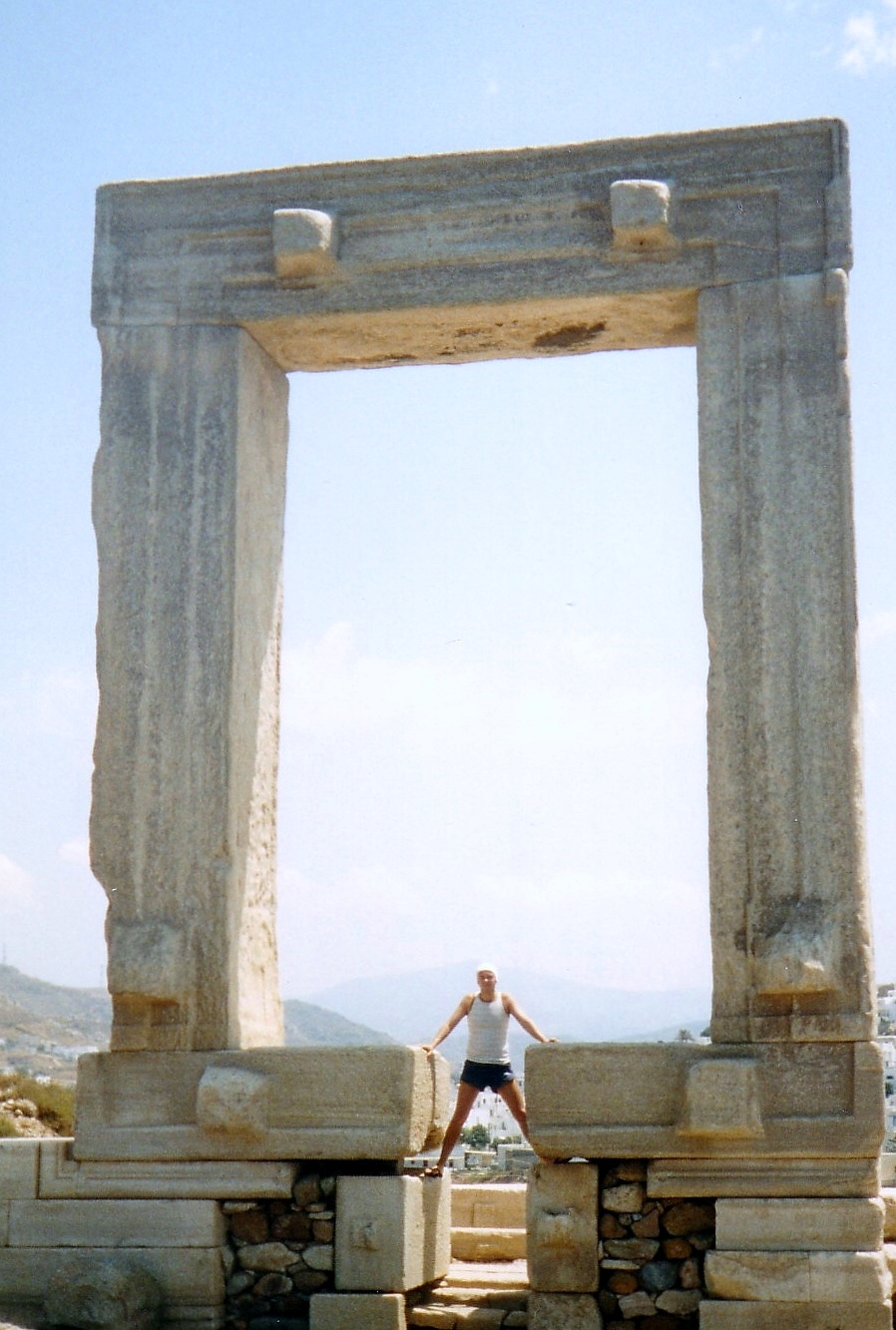
The awesome Naxos arch: the entrance to Apollo's Temple.
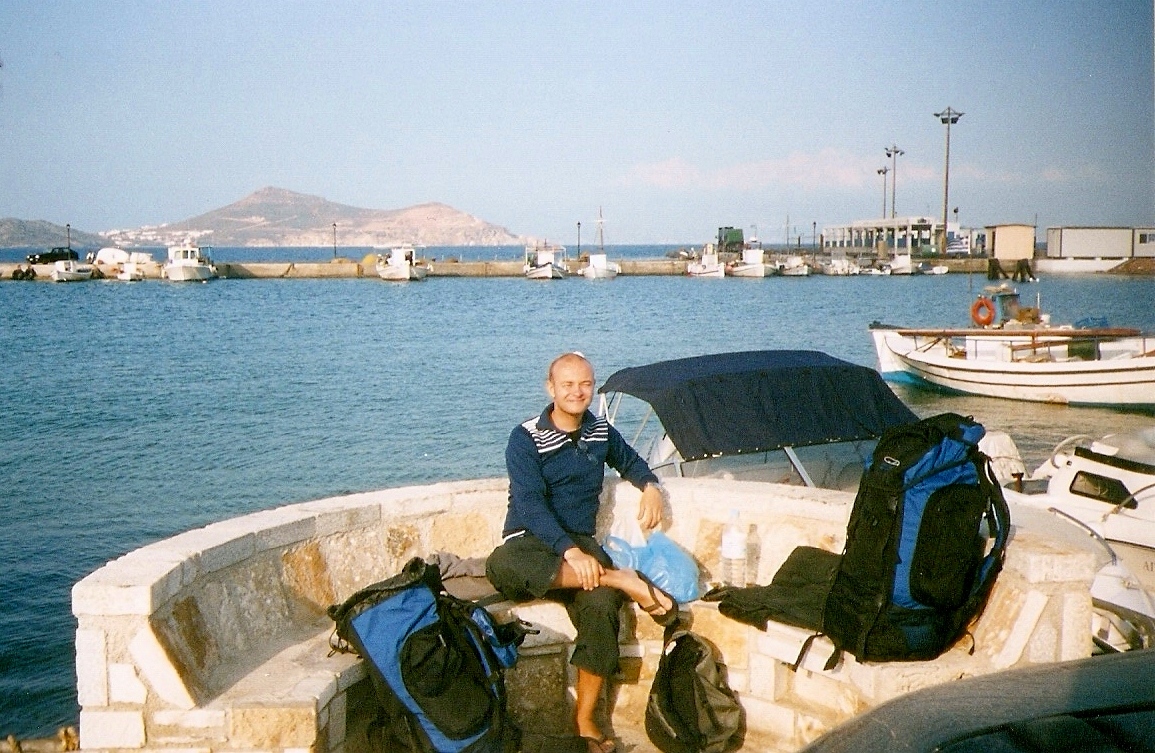
Waiting for the early morning ferry at Naxos harbour. It was delayed - and our pack of cards were a shrewd backpacker move.
ios
Ios was our last island before beginning the long watery road back to the Greek capital. This was rockier island compared to all of the others we had visited, but it did come graced with beautiful blue-domed Greek Orthodox churches and an impressive amphitheatre. By this time my rash had cleared up but I limited my time in the sun nonetheless out of an abundance of caution. The impromptu purchase of a beach parasol meant that I could still enjoy the most quintessential of Greek past times - sunbathing - on Manganari beach without aggravating the rash back into existence.
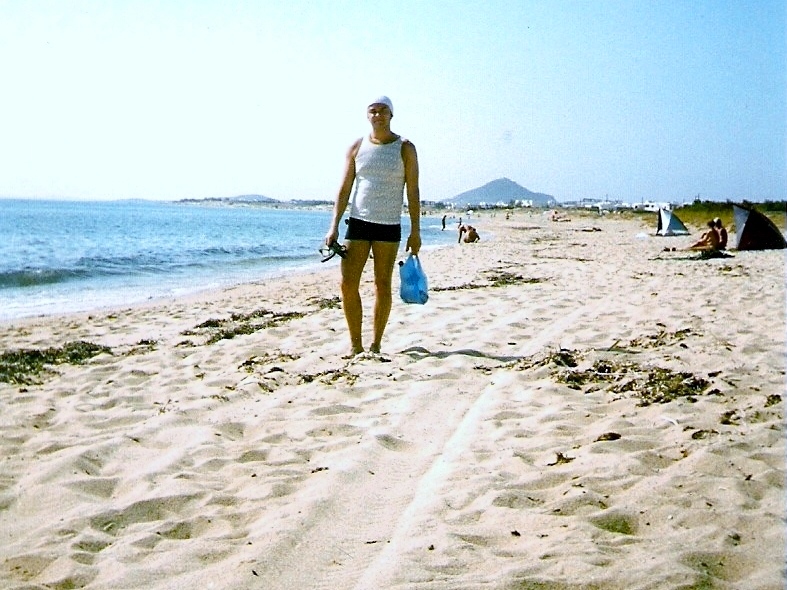
Manganari Beach on the south coast of Ios.
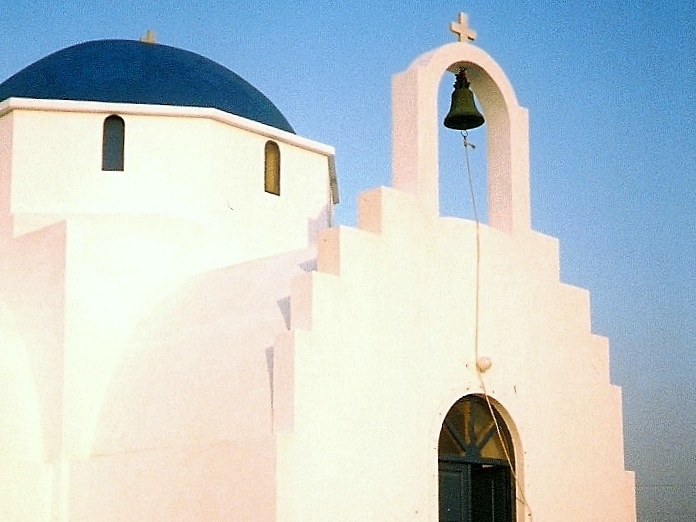
A Greek orthodox church with characteristic blue dome.
travel tips, links & resources
- Have a set price in mind for your island accommodation. Islanders are keen to let their rooms and it is worth bearing in mind that they are limited by the number of arrivals: if you are on the last ferry of the day, you can potentially bag a deal.
- Take a pen and paper with you for bartering with locals when you step off the ferry so that you can be very clear about prices and how many nights. It's unsurprising that clarity can fall between the cracks when the ferry is honking its horn, people are shouting all around you and there is more than one language involved.
- It is easy to strike a deal with locals if you are planning to stay more than one night. They will often drop prices if you're willing to stay two or more nights in their room/garage/garden shed - presumably because this means they do not have make the journey back down to the harbour the following day and endure the process of finding another guest.
- Try to spread your hops amongst famous, but also the lesser-known, islands - particularly if you want to avoid crowded beaches and high prices. Places like Mykonos and Santorini are two of the busiest and, if you want a quieter time of it, best avoided. It's nice to head off the beaten tourist trail when it comes to island hopping in Greece as it's probably your best chance of experiencing Greece at its most authentic.
- Take a pack of cards if you're going to be using the ferries. They are notoriously unreliable and cards are a simple tech-free way to help while away the time without draining your phone battery.
- Some ferries were far busier than others. How busy your ferry is depends largely on its departure and destination points, as well as the time of dayyou are travelling.
you may also like
